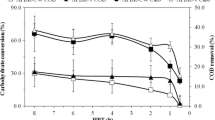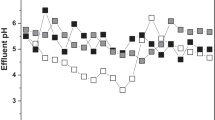Abstract
This study investigated the effect of reduced pressure on biohydrogen production in an upflow anaerobic sludge blanket (UASB) reactor from whey permeate. The results showed that the reduced pressure fermentation was more effective in enhancing biohydrogen production than dark fermentative hydrogen production at atmospheric pressure. Mesophilic fermentative biohydrogen production was investigated at a constant hydraulic retention time (HRT) of 24 h and increasing organic loading rates (OLRs) of 20, 25, 30, 35 kg COD/m3 day. The reduced pressure fermentation was successfully operated at all OLRs tested. The maximum proportion of hydrogen in biogas of 47.7 %, volumetric hydrogen production rate (VHPR) of 7.10 L H2/day and hydrogen yield of 4.55 mol H2/kg COD removed occurred at the highest OLR. Increase in OLR affected the hydrogen production in UASB reactor exploited at atmospheric pressure. The reduced pressure process was able to remarkably improve the biohydrogen performance at high OLRs.




Similar content being viewed by others
References
Zhang XF, Zhang SY, Hu ZY, Yu G, Pei CH, Sa RN (2012) Identification of connection units with high GHG emissions for low-carbon product structure design. J Clean Prod 27:118–125
Kim DH, Kim MS (2013) Development of a novel three-stage fermentation system converting food waste to hydrogen and methane. Bioresour Technol 127:267–274
Keskin T, Abo-Hashesh M, Hallenbeck PC (2011) Photofermentative hydrogen production from wastes. Bioresour Technol 102:8557–8568
Guo XM, Trably E, Latrille E, Carrère H, Steyer JP (2010) Hydrogen production from agricultural waste by dark fermentation: a review. Int J Hydrog Energy 35:10660–10673
Chu CF, Xu KQ, Li YY, Inamori Y (2012) Hydrogen and methane potential based on the nature of food waste materials in a two-stage thermophilic fermentation process. Int J Hydrog Energy 37:10611–10618
Lee KS, Tseng TS, Liu YW, Hsiao YD (2012) Enhancing the performance of dark fermentative hydrogen production using a reduced pressure fermentation strategy. Int J Hydrog Energy 37:15556–15562
Kim DH, Kim SH, Kim HW, Kim MS, Shin HS (2011) Sewage sludge addition to food waste synergistically enhances hydrogen fermentation performance. Bioresour Technol 102:8501–8506
Saady NMC (2013) Homoacetogenesis during hydrogen production by mixed cultures dark fermentation: unresolved challenge. Int J Hydrog Energy 38:13172–13191
Dinamarca C, Bakke R (2012) Simultaneous hydrogen production and consumption in anaerobic mixed culture fermentation. Int J Energy Environ 3:323–332
Dinamarca C, Bakke R (2009) Apparent hydrogen consumption in acid reactors: observations and implications. Wat Sci Technol 59:1441–1447
Nie YQ, Liu H, Du GC, Chen J (2009) Acetate production by a coupled syntrophic acetogenesis with homoacetogenesis process: effect of sludge inoculum concentration. Environ Technol 30:141–150
Levin DB, Pitt L, Love M (2004) Biohydrogen production: prospects and limitations to practical application. Int J Hydrog Energy 29:173–185
Sonnleitner A, Peintner C, Wukovits W, Friedl A, Schnitzhofer W (2012) Process investigations of extreme thermophilic fermentations for hydrogen production: effect of bubble induction and reduced pressure. Bioresour Technol 118:170–176
Zeidan AA, Van Niel EWJ (2010) A quantitative analysis of hydrogen production efficiency of the extreme thermophile Caldicellulosiruptor owensensis OLT. Int J Hydrog Energy 35:1128–1137
Kim DH, Han SK, Kim SH, Shin HS (2006) Effect of gas sparging on continuous fermentative hydrogen production. Int J Hydrog Energy 31:2158–2169
Mizuno O, Dinsdale R, Hawkes FR, Hawkes DL, Noike T (2000) Enhancement of hydrogen production from glucose by nitrogen gas sparging. Bioresour Technol 73:59–65
Nguyen TAD, Han SJ, Kim JP, Kim MS, Sim SJ (2010) Hydrogen production of the hyperthermophilic eubacterium, Thermotoga neapolitana under N2 sparging condition. Bioresour Technol 101:38–41
Ren NQ, Gong ML (2006) Acclimation strategy of a biohydrogen producing population in a continuous-flow reactor with carbohydrate fermentation. Eng Life Sci 6:403–409
APHA (1995) Standard methods for the examination of water and wastewater. 19th ed. American Public Health Association, New York
Mandal B, Nath K, Das D (2006) Improvement of biohydrogen production under decreased partial pressure of H2 by Enterobacter cloacae. Biotechnol Lett 28:831–835
Beckers L, Hiligsman S, Masset J, Hamilton C, Thonart P (2012) Effects of hydrogen partial pressure on fermentative biohydrogen production by a chemotropic Clostridium bacterium in a new horizontal rotating cylinder reactor. Energy Procedia 29:34–41
Junghare M, Subudhi S, Lal B (2012) Improvement of hydrogen production under decreased partial pressure by newly isolated alkaline tolerant anaerobe, Clostridium butyricum TM-9A: optimization of process parameters. Int J Hydrog Energy 37:3160–3168
Sivaramakrishna D, Sreekanth D, Himabindu V, Lakshmi Narasu M (2010) Thermo-acidophilic biohydrogen production from rice bran de-oiled wastewater by selectively enriched mixed culture. Int J Energy Environ 1:657–666
Cheong DY, Hansen CL (2006) Acidogenesis characteristics of natural, mixed anaerobes converting carbohydrate-rich synthetic wastewater to hydrogen. Process Biochem 41:1736–1745
Kraemer JT, Bagley DM (2008) Measurement of H2 consumption and its role in continuous fermentative hydrogen production. Water Sci Technol 57:681–685
Hussy I, Hawkes FR, Dinsdale R, Hawkes DL (2003) Continuous fermentative hydrogen production from a wheat starch co-product by mixed microflora. Biotechnol Bioeng 84:619–626
Tanisho S, Kuromoto M, Kadokura N (1998) Effect of CO2 removal on hydrogen production by fermentation. Int J Hydrog Energy 3:559–563
van Groenestijn JW, Hazewinkel JHO, Nienoord M, Bussmann PJT (2002) Energy aspects of biological hydrogen production in high rate bioreactors operated in the thermophilic temperature range. Int J Hydrog Energy 27:1141–1147
Nguyen VD, Kosuge H, Auresenia J, Tan R, Brondial Y (2009) Effect of vacuum pressure on ethanol fermentation. J Appl Sci 9:3020–3026
De Gioannis G, Friargiu M, Massi E, Muntoni A, Polettini A, Pomi R, Spiga D (2014) Biohydrogen production from dark fermentation of cheese whey: influence of pH. Int J Hydrog Energy 39:20930–20941
Perna V, Castelló E, Wenzel J, Zampol C, Fontes Lima DM, Borzacconi L, Varesche MB, Zaiat M, Etchebehere C (2013) Hydrogen production in an upflow anaerobic packed bed reactor used to treat cheese whey. Int J Hydrog Energy 38:54–62
Azbar N, Dokgöz F, Keskin T, Korkmaz KS, Syed HM (2009) Continuous fermentative hydrogen production from cheese whey wastewater under thermophilic anaerobic conditions. Int J Hydrog Energy 34:7441–7447
Venetsaneas N, Antonopoulou G, Stamatelatou K, Kornaros M, Lyberatos G (2009) Using cheese whey for hydrogen and methane generation in a two-stage continuous process with alternative pH controlling approaches. Bioresour Technol 100:3713–3717
Kisielewska M, Wysocka I, Rynkiewicz MR (2014) Continuous biohydrogen and biomethane production from whey permeate in a two-stage fermentation process. Environ Prog Sustain Energy 33:1411–1418
Acknowledgments
The research was supported by the National Science Centre, Poland (N N 523 555138) and the Project No. 18.610.008-300 from the University of Warmia and Mazury in Olsztyn.
Author information
Authors and Affiliations
Corresponding author
Rights and permissions
About this article
Cite this article
Kisielewska, M., Dębowski, M. & Zieliński, M. Improvement of biohydrogen production using a reduced pressure fermentation. Bioprocess Biosyst Eng 38, 1925–1933 (2015). https://doi.org/10.1007/s00449-015-1434-3
Received:
Accepted:
Published:
Issue Date:
DOI: https://doi.org/10.1007/s00449-015-1434-3




